Moira Butterfield's Blog, page 61
August 27, 2015
In the Beginning there were Folk Tales (by Malachy Doyle)
My very first picture book was The Great Castle of Marshmangle. I wrote it 19 years ago, and life was never the same again.
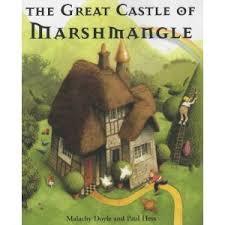
I'd been writing for two or three years by then, but in October 1996 I went on a week-long Writing for Children course at the Ty Newydd residential writing centre in Wales. The tutors were Kevin Crossley-Holland and Valerie Bloom, and not only were they brilliant, but they were immensely encouraging of me and my writing. I've since taught courses at Ty Newydd with both Kevin and Valerie, and it's always a delight to be giving back to new writers, a thrill to be back at such a wonderful place, and a particular delight to see them both again.

Kevin talked a lot about retelling folk tale, and about the responsibilities of approaching traditional material.
'Yes,' he said, 'many folk tales are dark, but naming the terrors helps children understand them - it's damaging to pretend there are no terrors.'
Yes, he said, they may be about people a world and an age away from us, but 'the deeper we look the more we're willing to grant humanity to those who are unlike us - to see that they are who we are - to realise that there's so little difference between us all that it's not worth mentioning.'
'Folk tale is healing and reconciliatory' he said. 'It looks for common ground between all of us who are human. The stories decode a hidden world but also celebrate a shared identity.'
(And yes, I was taking notes, and yes, I have them still. I was a most determined apprentice!)
He asked us to find a folk tale, to take a folk-motif, and make it our own. He told us that his book Storm, one of my all-time favourites, came from an eight line section in a Scottish folk tale of a girl who goes on a night journey. I found a story called The Ghosts and the Game of Football in a Patrick Kennedy collection and turned it into one called Famous Seamus that went down a treat on the Friday night read-around. It eventually found its form as The Football Ghosts, published nine years later by Egmont in their Banana Books strand - particularly pleasing as Kevin's Storm, a Carnegie medal winner, was also a Banana Book.
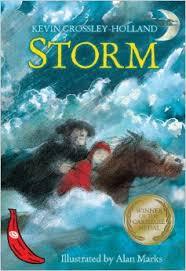
And I've been doing it ever since - playing with folk tale. Probably somewhere approaching half of my books, including many of my picture books, either retell folk tales or more often use lines, ideas, motifs from folk tales as a starting point. If they've survived for hundreds, for thousands of years, changing with every telling, then there's obviously some core of truth and relevance and entertainment that will survive one more retelling, one more adaptation.
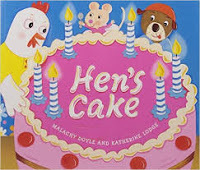
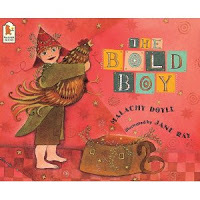
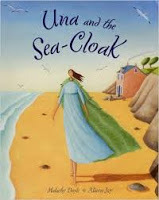
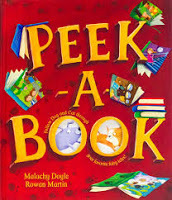
I got back from Ty Newydd in October 96, all fired up and searching for folk-tale inspiration. I was reading Ciaran Carson's superb book on Irish traditional music, Last Night's Fun, and was very taken with a story he quoted from the musician and story-collector Seamus Ennis. (It also appears in Joseph Jacobs' English Fairy Tales as Master of all Masters). So I wrote a picture book, and then, just to be sure, rang Ciaran Carson to check he didn't mind (and to clear with him that there weren't likely to be any copyright problems). Faber and Andersen made immediate offers, I went with Andersen, and it became my first book with the legendary Klaus Flugge (and the very lovely editor, Janice Thompson).
I had great fun, aided by my then teenage daughter Hannah (who's recently illustrated my Pete and the Five-a-Side Vampires), coming up with all the wordplay: Smoulderglow for fire, Soggadrop for water, Sandcastle Stompers for wellington boots, Brainbox Banana for a top hat... A teacher once told me her class had found the book invaluable when they were studying kennings - and was shocked when I told the class I hadn't a clue what one was. Oh, and I just loved the illustrations for the book by the masterly Paul Hess
It got loads of foreign editions and I was up and running: thanks to Kevin and Valerie, to Ty Newydd, to the wonderful and never-ending resource that is traditional story.
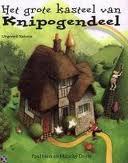
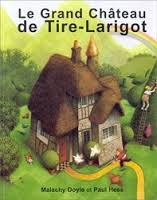
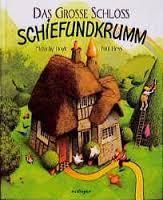

I'd been writing for two or three years by then, but in October 1996 I went on a week-long Writing for Children course at the Ty Newydd residential writing centre in Wales. The tutors were Kevin Crossley-Holland and Valerie Bloom, and not only were they brilliant, but they were immensely encouraging of me and my writing. I've since taught courses at Ty Newydd with both Kevin and Valerie, and it's always a delight to be giving back to new writers, a thrill to be back at such a wonderful place, and a particular delight to see them both again.

Kevin talked a lot about retelling folk tale, and about the responsibilities of approaching traditional material.
'Yes,' he said, 'many folk tales are dark, but naming the terrors helps children understand them - it's damaging to pretend there are no terrors.'
Yes, he said, they may be about people a world and an age away from us, but 'the deeper we look the more we're willing to grant humanity to those who are unlike us - to see that they are who we are - to realise that there's so little difference between us all that it's not worth mentioning.'
'Folk tale is healing and reconciliatory' he said. 'It looks for common ground between all of us who are human. The stories decode a hidden world but also celebrate a shared identity.'
(And yes, I was taking notes, and yes, I have them still. I was a most determined apprentice!)
He asked us to find a folk tale, to take a folk-motif, and make it our own. He told us that his book Storm, one of my all-time favourites, came from an eight line section in a Scottish folk tale of a girl who goes on a night journey. I found a story called The Ghosts and the Game of Football in a Patrick Kennedy collection and turned it into one called Famous Seamus that went down a treat on the Friday night read-around. It eventually found its form as The Football Ghosts, published nine years later by Egmont in their Banana Books strand - particularly pleasing as Kevin's Storm, a Carnegie medal winner, was also a Banana Book.

And I've been doing it ever since - playing with folk tale. Probably somewhere approaching half of my books, including many of my picture books, either retell folk tales or more often use lines, ideas, motifs from folk tales as a starting point. If they've survived for hundreds, for thousands of years, changing with every telling, then there's obviously some core of truth and relevance and entertainment that will survive one more retelling, one more adaptation.




I got back from Ty Newydd in October 96, all fired up and searching for folk-tale inspiration. I was reading Ciaran Carson's superb book on Irish traditional music, Last Night's Fun, and was very taken with a story he quoted from the musician and story-collector Seamus Ennis. (It also appears in Joseph Jacobs' English Fairy Tales as Master of all Masters). So I wrote a picture book, and then, just to be sure, rang Ciaran Carson to check he didn't mind (and to clear with him that there weren't likely to be any copyright problems). Faber and Andersen made immediate offers, I went with Andersen, and it became my first book with the legendary Klaus Flugge (and the very lovely editor, Janice Thompson).
I had great fun, aided by my then teenage daughter Hannah (who's recently illustrated my Pete and the Five-a-Side Vampires), coming up with all the wordplay: Smoulderglow for fire, Soggadrop for water, Sandcastle Stompers for wellington boots, Brainbox Banana for a top hat... A teacher once told me her class had found the book invaluable when they were studying kennings - and was shocked when I told the class I hadn't a clue what one was. Oh, and I just loved the illustrations for the book by the masterly Paul Hess
It got loads of foreign editions and I was up and running: thanks to Kevin and Valerie, to Ty Newydd, to the wonderful and never-ending resource that is traditional story.



Published on August 27, 2015 20:00
August 23, 2015
What’s in it for the Adults? by Rebecca Colby, Guest Blogger
Hands up if you’ve ever done what I’ve done and hidden your child’s favourite picture book? This is the book they ask you to read over and over (and over!) to the point where you can’t bear to ever read it again. While I can’t see your hands, I’m willing to bet I’m not alone.
I admit this isn’t a kind thing to do, but neither is inflicting the same story on an adult every night for months on end—especially one that doesn’t appeal to them. And that is the trick to writing a good picture book—ensuring your book holds strong appeal for both children and adults.
So what elements help guarantee an adult reader will want to read your book more than once? In other words, what’s in it for the adults?
HumourRegardless of age, everyone loves a good laugh. But humour is subjective, and certainly some forms of humour are more readily understood by an adult audience. One, in particular, is satire. Dr. Seuss did satire so well.
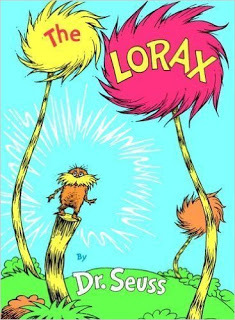
As a young child I loved his book, The Lorax, for its nonsense words and fun rhymes. It never failed to bring a smile to my face and it was the one book I kept renewing from the library (and consequently asking my mother to read over and over).
However, it wasn’t until I reread this book as an adult that I appreciated Seuss’ wit and the satirical poke at environmental issues. Okay, so it isn’t laugh-out-loud funny, but there is a black humour to it that underlies a very important message, and as an adult this satirical humour makes me admire and appreciate Seuss’ work even more than I did as a child.
Humour can also come from intertextuality. This is when the author or illustrator makes references to other texts or images outside their book. For example in Margie Palatini and Guy Francis’ Mary had a Little Ham, the main character Stanley Snoutowski is a pig who seeks fame and fortune on Broadway.
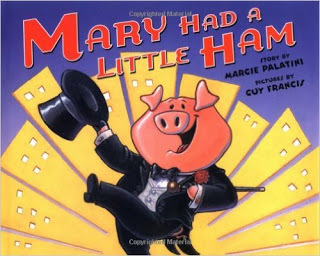
On one of the spreads, there are references to the shows Stanley performs in, like South Pigcific, The Pig and I, Pigmalion, Oinklahoma, The Pork Loin King, and Hamlet. Stanley even meets Broadway producers Hoggers and Hammerswine. While humorous for adults, these references often go over children’s heads.
Symbolism Here again, symbolism can also require readers to make connections to other books, artwork, etc. Anthony Browne’s Willy the Dreamer is a perfect example.
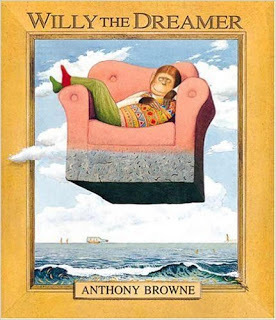
As Willy dreams of being a film star, a sumo wrestler, a ballet dancer, etc, children look for the many ways Browne has seamlessly incorporated symbolic bananas into the illustrations. Adults may be looking for this also, but at the same time they will note visual references and symbols that children may not have been exposed to yet, including symbols and references to the work of Matisse, Henri Rousseau and Salvador Dali.
Sophisticated textPicture books are aimed at our youngest of child audiences, but their language is anything but simple. In fact, picture books are often more sophisticated than early chapter books as they are intended to be read by fluent readers, rather than beginning readers.
Sophisticated text can be aimed at children as a means of extending their vocabulary, or to introduce them to literary devices. Or it can be employed to add something extra for the adults.
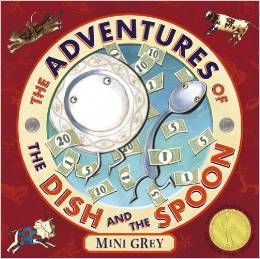
Here’s an example from Mini Grey’s book,The Adventures of the Dish and the Spoon, where she uses sophisticated language that could be interpreted both literally by children and figuratively by adults.
“But the dish was broken and so was I. I let them lock me up and turned away from the moon.”
The dish is literally broken, and children can see that the dish is in pieces. Adults, however, are able to take further meaning from this sentence. They understand that the dish and the spoon have been defeated by life.
Another Margie Palatini book, Bad Boys, illustrated by Henry Cole, uses sophisticated language in the form of word play.

Two wolves disguised as sheep try to fool three ewes into letting them join the flock with a view to eating them. Margie uses appropriate sophisticated language that only the adult audience will understand, but in a context that won’t detract from the story or confuse children. Some examples include:
On the lam. Fleece the flock. Pull the wool over their eyes. The two were in clover.
Interplay of text and illustrationsThis is a strong feature of nearly all picture books, and contributes to them working on more than one level. More often than not, the illustrations portray information that is not provided in the text. And because adults are better able to analyse the interaction between the text and illustrations, it’s an opportunity to add another layer to a book just for the adult audience.
A relatable one for parents is Boss Babyby Marla Frazee.
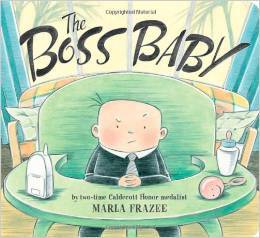
At one point, the text states that “He [Boss Baby] conducted meetings. Lots and lots and lots of meetings, many in the middle of the night.” What we wouldn’t get from the text without the illustrations is that the baby is actually throwing lots and lots and lots of tantrums, flanked by both parents as they attend to his needs of feedings, playtime, and nappy changes.
And let’s not forget the contradictory interplay of text and illustrations where the text tells one story, and the illustrations tell another diametrically opposed story. A great example is Bottomley Cattery by Peter Harris and Doffy Weir.
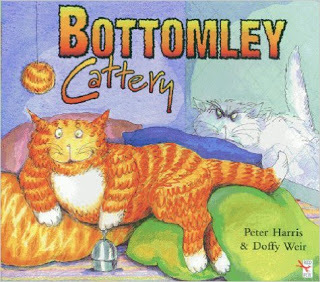
Bottomley isn’t happy about being left at the cattery while his human family go on holiday, but he tries to make the best of it. Or so he says. He claims to have made lots of friends and not to have caused a fuss. But the illustrations, of course, paint a very different picture.
One more book I’d like to mention here is Battle Bunny by Jon Scieszka, Mac Barnett and Matthew Myers.
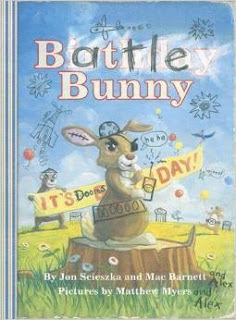
It’s two books in one, with the second story drawn and written over the top of the first. The main character, Alex, is given a book called Birthday Bunny, which he soon defaces and rewrites. In the new story, Battle Bunny is unleashing an evil plan which only Alex can stop. This new story is hand-written and hand-drawn in pencil over the top of the original. The interplay between the two texts and the two sets of illustrations makes for a brilliant concept that most adults will appreciate far more than children. Not to mention the fact that it is nearly impossible to read this book aloud. You end up reading only one story at a time, whereas by reading it silently, you can read the stories simultaneously.
Strong emotional pullWhatever you do, make your reader feel something! Engage them emotionally, be it through humour, joy, fear, or even sadness. Readers are less apt to forget a book—or want to put it down—if it has pulled at their heart strings or touched their inner core. Adults are no different this way. I may hide my children’s books on occasion, but I’d never hide Debi Gliori’s book, No Matter What.
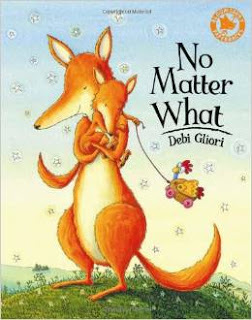
And that’s because it speaks to my soul. It has a powerful message about unconditional, never-ending love that elicits a strong feeling from me. Admittedly, that experience is one of tearing up—but that’s exactly why I pick it up as an adult over and over again. I want to relive that same powerful experience.
Challenge readers’ expectationsThere are lots of ways to do this. Two I’m going to mention are twist endings and using non-traditional story structures. Do you want to keep your adult reader engaged? Then surprise them. Keep them guessing the outcome of your story until the end. Children enjoy predictability to a certain extent but even they will probably prefer a book that surprises them with an unexpected ending.
A story that does just that is Waking Beauty by Leah Wilcox and Lydia Monks.
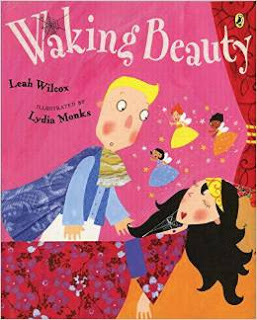
It’s a fractured fairy tale and we all know roughly how the story is supposed to pan out--with the prince waking his beauty with a kiss. But although the prince gets his kiss, the ending is anything but predictable. (And because I want you to be surprised when you read it, I’m not going to spoil the ending here.)
Another way to challenge reader’s expectations is to give them a story structure they’ve not seen before. Most picture book writing advice recommends the use of the standard story structure with a beginning, middle and end, but as with so many writing rules, once you know them, you can start breaking them. And here are two that break them so well:
The Day the Crayons Quitby Drew Daywalt and Oliver Jeffers (structured as a series of letters from crayons)
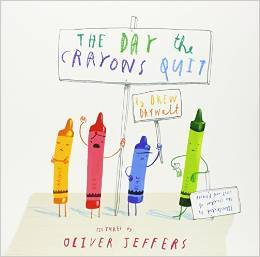
and Shark vs Train by Chris Barton and Tom Lichtenheld (structured as a series of competitions between a shark and a train without a decisive winner).
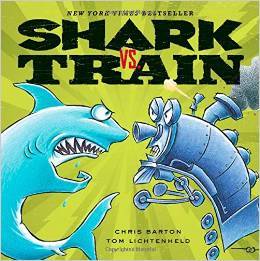
Before I wrap up, I want to thank the Picture Book Den for hosting me today! It’s been fun finding examples to share. And if there are any examples you’d like to share, or elements I’ve missed (I’m sure there are plenty!), please feel to tell me about them in the comments.
The bottom line is great picture books hold universal appeal. Make sure your own books offer something for everyone, regardless of their age. And bear in mind, your books need to hold a reader’s attention over repeated readings. Like this one…
Oops! That’s strange. I seem to have mislaid my favourite picture book. I just had it out last night reading it to my kids a few times. I was going to tell you about it and explain why it’s my favourite and perhaps read it to my children again tonight but it’s not where I normally keep it on the bookshelf. I wonder if they’ve seen it?!
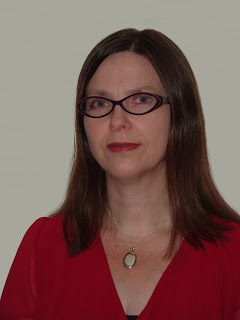
Rebecca is a picture book author and poet. Her books include: It’s Raining Bats & Frogs (Feiwel & Friends/Macmillan, 2015) and There was a Wee Lassie who Swallowed a Midgie (Floris Picture Kelpies, 2014).
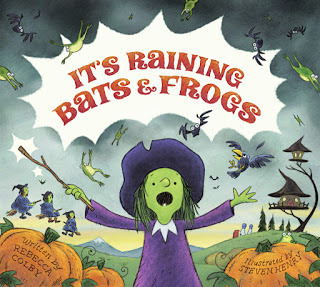
Before writing for children, Rebecca inspected tights, taught English in Taiwan, worked for a Russian comedian and travelled the world as a tour director. Learn more about Rebecca at www.rebeccacolbybooks.comor follow her on Twitter at @amscribbler.
Published on August 23, 2015 01:10
August 18, 2015
Book Authors Resale Rights (BARR) - Lynne Garner
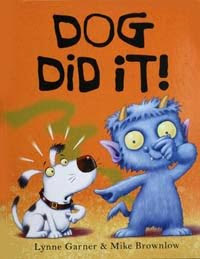 I recently stumbled across an old news piece (16/06/14) released by the ALCS (Authors Licensing and Collecting Society) stating they had teamed up with Book Barn International (a second hand book seller) were launching a pilot scheme that would compensate authors when a second-hand version of their book was sold. This system is known as the Book Authors Resale Rights (BARR) and basically pays a small percentage of the sale price to the original author.
I recently stumbled across an old news piece (16/06/14) released by the ALCS (Authors Licensing and Collecting Society) stating they had teamed up with Book Barn International (a second hand book seller) were launching a pilot scheme that would compensate authors when a second-hand version of their book was sold. This system is known as the Book Authors Resale Rights (BARR) and basically pays a small percentage of the sale price to the original author.At present authors receive nothing on the resale of their book even if the book is still in print, which obviously means they're losing income from sales of their books when sold new. This collaboration between the ALCS and BBI will mean authors will receive an income from second-hand books sales alongside their regular payments from the ALCS.
I must admit it has always been a niggle of mine that under certain circumstances film makers earn when their film is watched, actors receive repeat fees, composers and musicians earn when their work is sold. Yet the hundreds of thousands of second-hand books sold each year earn the writer nothing, even though the copyright on these books is often still owned by the author.
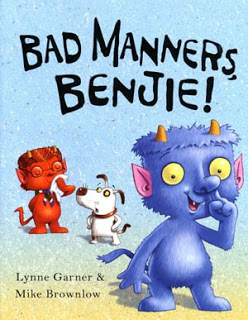 Out of curiosity I visited Amazon to see how many second-hand copies of my last two picture books were available. I discover there were 5 paperback copies and 4 hardback copies of Dog Did It for sale and 7 paperbacks and 1 hardback of Bad Manners Benjie for sale. I know we’re not talking huge numbers here. However many authors including myself have seen income drop by 29% since 2005. It is also a stark reality that only
“a handful of highly successful authors make a very good living; for the majority, earning from writing falls well below subsistence levels"
and nearly 90% of writers now need to earn money from other sources other than writing. Unfortunately I’m one of those 90% so every penny earned from the sale of my books really does count.
Out of curiosity I visited Amazon to see how many second-hand copies of my last two picture books were available. I discover there were 5 paperback copies and 4 hardback copies of Dog Did It for sale and 7 paperbacks and 1 hardback of Bad Manners Benjie for sale. I know we’re not talking huge numbers here. However many authors including myself have seen income drop by 29% since 2005. It is also a stark reality that only
“a handful of highly successful authors make a very good living; for the majority, earning from writing falls well below subsistence levels"
and nearly 90% of writers now need to earn money from other sources other than writing. Unfortunately I’m one of those 90% so every penny earned from the sale of my books really does count. In a recent update (30/07/15) William Prior, founder of Book Barn International states "I have tried to persuade Book Barn International’s competitors to adopt BARR. They all tell me they see the justice and point of the scheme, but either their accountants or their commerciality won’t sanction it." Come on folks without us you wouldn't have a product to sell and without our small slice of the pie many of us may have to give up writing in a bid to find an alternate way of making a living.
To round off this post I urge everyone to source (when ever possible) their second-hand books from Book Barn International and show your support for the BARR system. Also if you have any family or friends who have sway with any second-hand book sellers support the cause and have a chat with them, see if you can talk them into putting 'justice' before profit.
Last but not least I'd like to thank William Prior for his continued fight on our behalf.
Lynne Garner
Published on August 18, 2015 11:12
August 12, 2015
Different voices by Jane Clarke
Do you put on different voices when you're reading picture books aloud? I do. I can't help it.
I go for perky and interested when I read the Very Hungry Caterpillar by Eric Carle (the pop! is key to this narrator's voice I think - who doesn't love a good sound effect?)
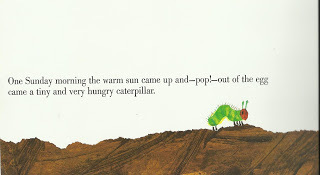
I adopt a tone of total innocence when I read the hilarious Bottomley books by Peter Harris and Doffy Weir. These books are told from first person (or should I say cat) point of view with the text contradicting the pictures. Here's a page from Bottomley Cattery.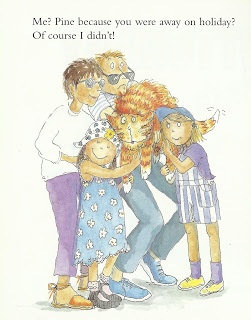
And I have a different voice for each animal in the Gruffalo, some scary, some scared, some soft, some loud, some hissy. Reading the Gruffalo aloud is a bit like acting.
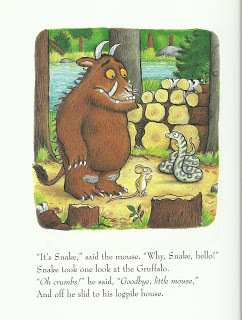 a page from The Gruffalo by Julia Donaldson and Axel Scheffler
a page from The Gruffalo by Julia Donaldson and Axel Scheffler
I have voices for all the characters I write in my own picturebooks and tones of voices in my head for the characters in the texts I'm writing. A few of my books have audio versions. It's strange, but wonderfully magical, to hear an actor voice them.
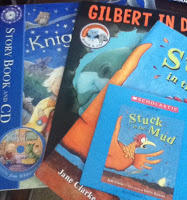 Knight Time read by Jane Whittenshaw, Gilbert the Great and Gilbert in Deep read by Dervla Kirwan, Stuck in the Mud ready by Cassandra Morris
Knight Time read by Jane Whittenshaw, Gilbert the Great and Gilbert in Deep read by Dervla Kirwan, Stuck in the Mud ready by Cassandra Morris
Even for non actors like me, using different voices and making different sound effects when you're reading a picture book aloud helps the reader and the child listener enter the magical world of make believe.
It's fun to experiment using different voices when you read a picture book aloud, and it's fun to try out different voices when you're writing a picture book text. Narrator, first person, second person or third – every voice can be different and distinct.
What voices stand out for you?
Jane's proud and excited to announce that her new picture book, Who Woke the Baby is published this month.It's crammed full of yummy illustrations by Charles Fuge and there are plenty of animal noises to make when you read it out loud.

I go for perky and interested when I read the Very Hungry Caterpillar by Eric Carle (the pop! is key to this narrator's voice I think - who doesn't love a good sound effect?)

I adopt a tone of total innocence when I read the hilarious Bottomley books by Peter Harris and Doffy Weir. These books are told from first person (or should I say cat) point of view with the text contradicting the pictures. Here's a page from Bottomley Cattery.

And I have a different voice for each animal in the Gruffalo, some scary, some scared, some soft, some loud, some hissy. Reading the Gruffalo aloud is a bit like acting.
 a page from The Gruffalo by Julia Donaldson and Axel Scheffler
a page from The Gruffalo by Julia Donaldson and Axel SchefflerI have voices for all the characters I write in my own picturebooks and tones of voices in my head for the characters in the texts I'm writing. A few of my books have audio versions. It's strange, but wonderfully magical, to hear an actor voice them.
 Knight Time read by Jane Whittenshaw, Gilbert the Great and Gilbert in Deep read by Dervla Kirwan, Stuck in the Mud ready by Cassandra Morris
Knight Time read by Jane Whittenshaw, Gilbert the Great and Gilbert in Deep read by Dervla Kirwan, Stuck in the Mud ready by Cassandra MorrisEven for non actors like me, using different voices and making different sound effects when you're reading a picture book aloud helps the reader and the child listener enter the magical world of make believe.
It's fun to experiment using different voices when you read a picture book aloud, and it's fun to try out different voices when you're writing a picture book text. Narrator, first person, second person or third – every voice can be different and distinct.
What voices stand out for you?
Jane's proud and excited to announce that her new picture book, Who Woke the Baby is published this month.It's crammed full of yummy illustrations by Charles Fuge and there are plenty of animal noises to make when you read it out loud.

Published on August 12, 2015 23:00
August 2, 2015
Three Ways Authors Can Get the Most Out of their Computers • Jonathan Emmett
 I don't think I'd have made it as a professional author without a computer's help
I don't think I'd have made it as a professional author without a computer's helpA question children often ask me on school visits is “do you write with pen and paper or on a computer?”. I know there are some authors who swear by pen and paper, particularly for the first draft, and say that a computer would get between them and the story. For me it’s the other way around. I’m mildly dyslexic and doubt that I’d be able to make a living as a writer without a computer helping me to set-down, shape and polish my stories.
I’ve just gone without my computer for a week, while a faulty hard-drive was replaced. This absence reminded me how much I’ve come to depend on my computer and prompted me to write this post.
Here are three ways authors can get the most out of their computers. My own computer is an Apple Mac, and I’ve included some detailed instructions for other Mac users, but these tips also apply to Windows PCs.
First and foremost …
1: Learn to touch-typeIf you’re still pecking away at your keyboard with two fingers, you’re getting your ideas down on the page at a fraction of the rate you could be. Having been born in the dark ages, before computers were in every home, I taught myself to touch type on a mechanical typewriter using a Pitman typing book. These days, you can learn far more easily using typing-tutor software (you can find some recent reviews of some here. It’s never too late to learn. Touch-typing is an invaluable skill for anyone that uses a keyboard and I’ve never understood why it’s not routinely taught at an early age in UK schools.
 Use ten not two! Touch typing is an invaluable skill for any author and it's never too late too learn.
Use ten not two! Touch typing is an invaluable skill for any author and it's never too late too learn. 2: Have your computer read aloud to youIt’s good practice for any writer to read their work aloud, but it’s essential for picture book authors, as picture books are often read aloud to children by adults. Although I still read text aloud, I use my computer to do this most of the time. I'm not sure if this is linked to my dyslexia, but when I read something I've written aloud, my brain often glosses over errors and I read what I'd meant to type instead of what I've actually typed. However when I listen to the computer reading the same passage, the errors are far more conspicuous.
Having your computer read aloud is particularly useful when writing rhyming texts. Reading aloud is the only way to check that a rhyming text scans well, but if you’ve written the text yourself, you will have preconceptions as to the rhythm of a line and which words need emphasis. Someone reading the text for the first time won't share these preconceptions so you want to make sure that a rhyming text will still read well without them. One way around this is to ask someone else to read your text back to you, but their patience may begin to wear thin if you keep asking them to re-read the same lines, with minor variations, again and again. And after a few readings they'll begin to develop preconceptions of their own. A computer has infinite patience and is incapable of forming such preconceptions. It will give consistently impartial readings with even rhythm and emphasis, putting in appropriate pauses for commas and other punctuation. Standard computer speech used to be very flat and American sounding, but has come on in leaps and bounds in recent years. Macs now come with a range of English Language voices pre-installed with yet more available as free downloads (go to System Preferences>Dictations and Speech>Text to Speech and click “customise” to find them). You can find further instructions on how to use a Mac’s Text to Speech function here.
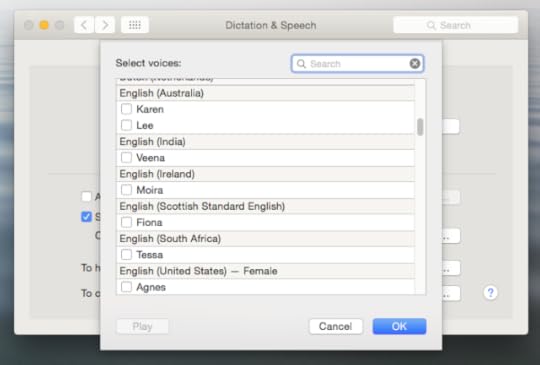 Macs can speak English in a variety of voices and accents, including Australian, Indian, Irish, Scottish and South African.
Macs can speak English in a variety of voices and accents, including Australian, Indian, Irish, Scottish and South African. It’s worth taking the time to choose a voice you like and to adjust the speed. My favourite is “Serena”, who speaks with an English accent. You can use the player below to hear what she sounds like reading the opening lines of The Silver Serpent Cup . The software makes the occasional mistake, (its pronunciation of 'noisy' in the passage below is slightly out) and it can slip up with homonyms. However it can cope surprisingly well with made-up words and generally does a remarkably good job.
Today the town of Furryville’s a very noisy place,
Crammed with crowds of creatures getting ready for a race.
The air is filled with honking horns and engines revving up,
As racers take their places for THE SILVER SERPENT CUP.
3. Use software that suits the way you workMost of the publishers I work with expect manuscripts to be sent to them as Microsoft Word files and when I first became a writer, I used to write directly into Word. However as the years have gone by, Word has become increasingly unwieldy to use, with half of it’s functions hidden away in a bewildering array of sub menus. There are now lots of cheaper applications available, some of which are far better suited to writing a book. About 9 years ago I started using Scrivener, an application designed specifically for authors. It provides a far cleaner, simpler interface than Word and allows authors to access and organise the myriad files, documents and web pages relating to their project through a single window instead of cluttering up the screen with half a dozen windows from various applications. And once you’ve finished a project, you can export it as a MS Word file to send to your publisher.
 The Silver Serpent Cup in Scrivener. Scrivener allows you to open multiple text documents, pdfs, web pages and
The Silver Serpent Cup in Scrivener. Scrivener allows you to open multiple text documents, pdfs, web pages andimages within a single application window. One of Ed Eaves' concept sketches is shown on the right.
I hope the tips above have proved useful. If you have any other computer tips for writers (perhaps you can tell Windows users how to get their computer reading aloud), please post them in the comments box below.
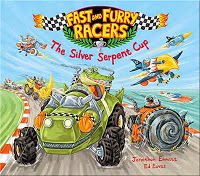 Jonathan Emmett's latest computer-assisted picture book is
Fast and Furry Racers: The Silver Serpent Cup
illustrated by Ed Eaves and published by Oxford University Press.
Jonathan Emmett's latest computer-assisted picture book is
Fast and Furry Racers: The Silver Serpent Cup
illustrated by Ed Eaves and published by Oxford University Press.Find out more about Jonathan and his books at his Scribble Street web site or his blog. You can also follow Jonathan on twitter @scribblestreet.
Published on August 02, 2015 22:30
July 28, 2015
Creative Crafts from Books by Abie Longstaff
I love the idea of books being cross-curricular, with 'We're going on a bear hunt' used to look at landscapes and nature, or 'The Very Hungry Caterpillar' to discuss life-cycles. My favourite way of playing with the ideas in books is to make crafts. I think it brings the stories alive.
Some bloggers do this very well (see www.playingbythebook.net). So do some schools. My daughter's class recently had to make the garage from David Almond's Skellig out of a shoebox, a project my eleven year-old loved.
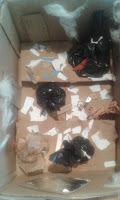 GarageWhen I write, I like to play around with different creative tools like paint, pencil and fabric. I find it helps me connect with the story and it creates a strong foundation to take to schools and lit fests later. Children love hearing about what has inspired the books and they have a lot of fun recreating or playing with the objects.
GarageWhen I write, I like to play around with different creative tools like paint, pencil and fabric. I find it helps me connect with the story and it creates a strong foundation to take to schools and lit fests later. Children love hearing about what has inspired the books and they have a lot of fun recreating or playing with the objects.
For Fairytale Hairdresser, of course, I have long-haired dolls for the children to style.
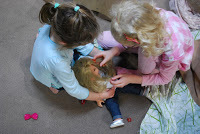
I like to have a range of dolls, representing the different fairy tale characters, even if it means having to source a mermaid tail, or dye a doll's hair to find the right shade of purple to become the Sugar Plum Fairy.
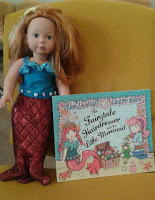 Tail made by Sally Channon (Salstuff)
Tail made by Sally Channon (Salstuff)
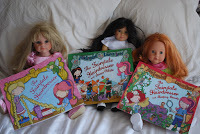 Rapunzel, Snow White and Sleeping Beauty
Rapunzel, Snow White and Sleeping Beauty
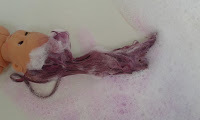 Hair dyed with sharpie ink
Hair dyed with sharpie ink
There are lots of craft projects you can make with children based on their favourite books, and some schools have come up with wonderful ideas. Grow House Forest School in Switzerland had a Fairytale Hairdresser craft day, with activities including building the Three Pigs' houses (and testing their strength using a hairdryer!)
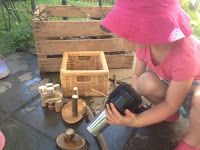
Children can do drawings of their favourite characters (see Lauren Beard's 'How to Draw a Singing Mermaid' in the Guardian here http://www.theguardian.com/childrens-...)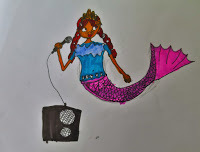
They can make maps tracking journeys across the book
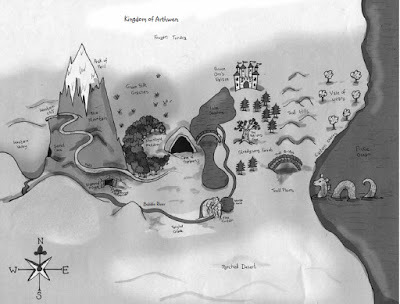 Map from The Magic Potions Shop, illus by Lauren Beardor buckets of potions
Map from The Magic Potions Shop, illus by Lauren Beardor buckets of potions
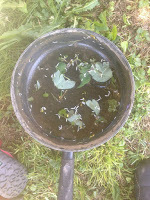
and there's ultimate tribute: dressing up as your favourite book character!
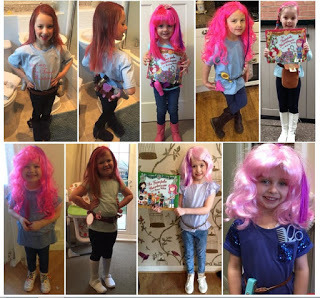 Kittie Laceys on World Book Day
Kittie Laceys on World Book Day
For my Magic Potions Shop series, I've been busy making teeny potions bottles.
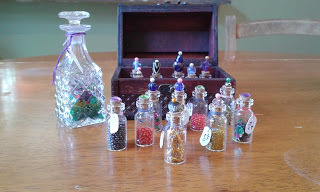 At events, we've been imagining our favourite potion (Flying Potion? Invisible Potion? Exploding Powder?) and drawing it or making it with glitter or feathers.
At events, we've been imagining our favourite potion (Flying Potion? Invisible Potion? Exploding Powder?) and drawing it or making it with glitter or feathers.
Let me know your craft ideas - I'm always looking for more projects! :)
(You can find lots of crafts, including activity sheets to download, on my website www.abielongstaff.com)
Some bloggers do this very well (see www.playingbythebook.net). So do some schools. My daughter's class recently had to make the garage from David Almond's Skellig out of a shoebox, a project my eleven year-old loved.
 GarageWhen I write, I like to play around with different creative tools like paint, pencil and fabric. I find it helps me connect with the story and it creates a strong foundation to take to schools and lit fests later. Children love hearing about what has inspired the books and they have a lot of fun recreating or playing with the objects.
GarageWhen I write, I like to play around with different creative tools like paint, pencil and fabric. I find it helps me connect with the story and it creates a strong foundation to take to schools and lit fests later. Children love hearing about what has inspired the books and they have a lot of fun recreating or playing with the objects.For Fairytale Hairdresser, of course, I have long-haired dolls for the children to style.

I like to have a range of dolls, representing the different fairy tale characters, even if it means having to source a mermaid tail, or dye a doll's hair to find the right shade of purple to become the Sugar Plum Fairy.
 Tail made by Sally Channon (Salstuff)
Tail made by Sally Channon (Salstuff) Rapunzel, Snow White and Sleeping Beauty
Rapunzel, Snow White and Sleeping Beauty Hair dyed with sharpie ink
Hair dyed with sharpie inkThere are lots of craft projects you can make with children based on their favourite books, and some schools have come up with wonderful ideas. Grow House Forest School in Switzerland had a Fairytale Hairdresser craft day, with activities including building the Three Pigs' houses (and testing their strength using a hairdryer!)

Children can do drawings of their favourite characters (see Lauren Beard's 'How to Draw a Singing Mermaid' in the Guardian here http://www.theguardian.com/childrens-...)

They can make maps tracking journeys across the book
 Map from The Magic Potions Shop, illus by Lauren Beardor buckets of potions
Map from The Magic Potions Shop, illus by Lauren Beardor buckets of potions
and there's ultimate tribute: dressing up as your favourite book character!
 Kittie Laceys on World Book Day
Kittie Laceys on World Book DayFor my Magic Potions Shop series, I've been busy making teeny potions bottles.
 At events, we've been imagining our favourite potion (Flying Potion? Invisible Potion? Exploding Powder?) and drawing it or making it with glitter or feathers.
At events, we've been imagining our favourite potion (Flying Potion? Invisible Potion? Exploding Powder?) and drawing it or making it with glitter or feathers.Let me know your craft ideas - I'm always looking for more projects! :)
(You can find lots of crafts, including activity sheets to download, on my website www.abielongstaff.com)
Published on July 28, 2015 23:54
July 23, 2015
Picture Book People - 1: Laurence Anholt
This is the first in an occasional series of blogs about their lives by some of the people whose work we here at the Den very much like and admire. We're delighted to welcome super-talented Laurence Anholt, whose work has been published all over the globe. He's written us a fascinating piece about his life story, which is one of great creativity and commitment, very influenced by fine art through the years. He's also sharing with us his surprising and intriguing new direction.
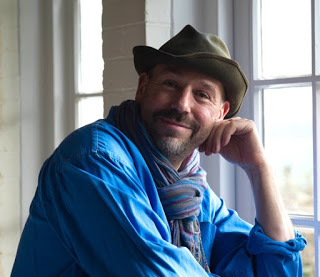 Here he is! Laurence Anholt with hat - Copyright: Julia Mear
Here he is! Laurence Anholt with hat - Copyright: Julia MearI’m generally a cheerful person so I’d like to think I didn’t make too much fuss when I was born on 4th August 1959 in Barnet. In theory that makes me a ‘Norf Lund’ner’ but it’s a bit more complicated than that because my dad was a Dutchman with family roots stretching all the way back to Persia.My siblings and I spent our early years in Holland and we went to little Dutch schools. Sadly I lost the language but what I retained is that celebrated Dutch liberalism along with a passion for Dutch art, especially van Gogh.
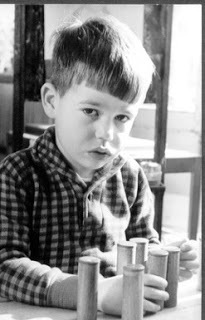 Me in my little Dutch Montessori School aged about 5
Me in my little Dutch Montessori School aged about 5Our family returned to the UK in time for part two of my education which became increasingly shambolic. I went to a mixed outward bound school where - so it seemed to me - you could choose whether you went to lessons or not… I chose not! I left school at 16 with almost no qualifications and a general sense of bewilderment.
My father had many good qualities but he was haunted by some devastating wartime experiences. To give some idea, he was amongst the group that liberated Bergen Belsen - not something you get over in a hurry. Perhaps it was understandable that he wasn’t a great mentor; but growing boys need male mentors and when they don’t have them they tend to drift into little gangs of other disaffected boys - I must admit I went a little wild in my teenage years and there are gaps in my CV where even I’m not sure what happened! I travelled; I worked in factories and kitchens and I had many fine adventures along the way. My most bizarre job was working as a bricky on a model village in Southern France. I laid tiny bricks and I think the wages were minuscule too! My main interests had always been English and Art and eventually I stumbled into the Foundation Course at Epsom School of Art where I grew my hair and threw some paint around.
At 19 I was passing through Oxford when I met a beautiful Irish girl, who became my best friend and partner for the next 35 years. Cathy was one of eight siblings; a student nurse who dreamed of becoming an artist. We had heard about the legendary Degree course at Falmouth School of Art, so the two of us assembled portfolios and hitchhiked to Cornwall. This was the late 1970’s and there were only 175 students in that hothouse of creativity. It was an amazing opportunity for self-discovery.
When we qualified we moved to London to take our Masters. Cathy went to the Royal College of Art and I studied Fine Art for three years in the scruffy splendour of the Royal Academy.
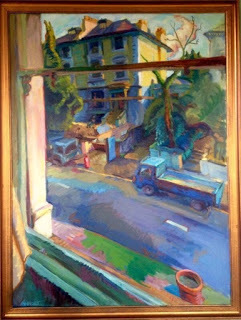 'Houses on Haverstock Hill' - an example of the paintings I was doing at the Royal Academy.
'Houses on Haverstock Hill' - an example of the paintings I was doing at the Royal Academy.We had not a penny between us, but I discovered a knack for carpentry and spent weekends and holidays building kitchens all over London. Around this time, my parents had settled in Dorset and whenever we visited, Cathy and I felt rejuvenated by the woods and the hills. It was the start of a love affair with the Westcountry - the Blue Lias of the Jurassic Coast gets right under your fingernails!
When our first daughter, Claire was born in 1984 I was over the moon. But I wanted to be a different kind of dad and began to think of ways in which I could work from home. That’s when we started looking at those lovely things called children’s books. Perhaps this could be a way of combining my passions - writing, drawing and inspiring kids.
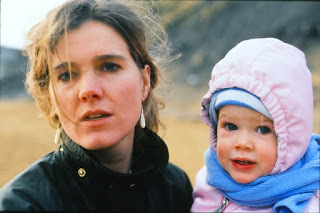 My lovely wife Cathy with our daughter Claire, on Charmouth Beach.
My lovely wife Cathy with our daughter Claire, on Charmouth Beach.At the time I was working as an art teacher and I entertained my class with stories about maverick characters such as Picasso, Cézanne and Matisse. This led me to write and illustrate ‘Camille and the Sunflowers’, a picture book about the friendship between Van Gogh and Camille Roulin, son of the famously bearded postmaster in Arles.
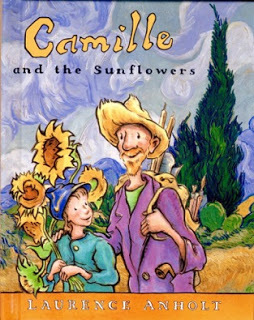
It was the first in what eventually became the Anholt’s Artists series published by Frances Lincoln in the UK and Barron’s in the U.S. In the last 25 years my series has translated into many languages and sold several million copies around the world.
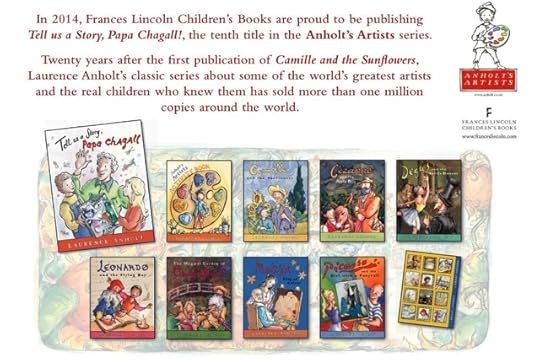
These books are a first introduction to great artists, seen from the perspective of a real child. They are fascinating to work on and I have met many relatives and acquaintances of the artists, such as Sylvette David, Picasso’s iconic Girl With A Ponytail in the 1950’s who has become a family friend.
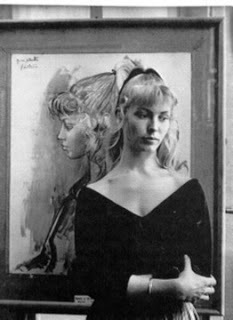 Sylvette David by Picasso portrait. Copyright: collection of Sylvette David
Sylvette David by Picasso portrait. Copyright: collection of Sylvette DavidI’m currently putting the final touches to the tenth story in the series, about that great feminist icon, Frida Kahlo and another real child. My working title is ‘Frida Kahlo and the Bravest Girl in the World’.
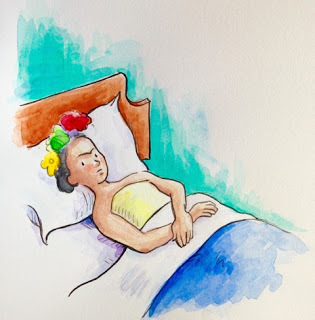
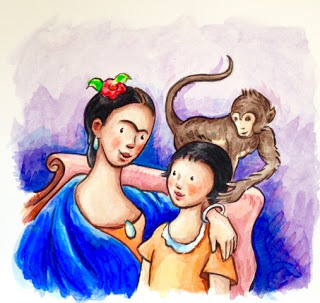 Two watercolour illustrations of Frida Kahlo. Copyright: Laurence Anholt.
Two watercolour illustrations of Frida Kahlo. Copyright: Laurence Anholt. In 1987 our beautiful twins, Tom and Maddy were born. Here they are face to face in their pram -
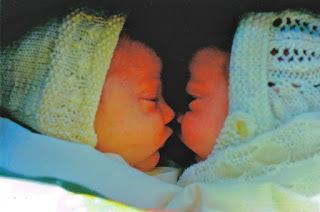
And it was at this time that we discovered our Willy Wonka ticket… in the countryside near Lyme Regis, we stumbled upon a rambling semi-derelict house with acres of tangled jungle, various crumbling outbuildings, a walled swimming pool filled with something resembling vegetable soup, and breathtaking views across the valley to the sea. The place was like a dream or a magical fairy tale (although the mortgage felt real enough!) Old Woodhouse had been long abandoned and it took years to put it straight - I lost count of the evenings I spent on the roof with a hammer, but for sixteen happy years this was our family home.
Making a living as an author or illustrator requires huge tenacity, but slowly our business grew. We’ve always worked without an agent - negotiating directly with publishers and with the wonderful Society of Authors at our side. Being agentless wasn’t a plan, we’ve just never made that connection, although it’s something I would consider for the future. One way or another, we were unbelievably fortunate to be working in the late ’80’s and early ’90’s. That was a Golden Time in children’s publishing, when the UK led the world with an astonishing range of imaginative picture books. It was possible to make a really good living by sitting in your studio, listening to Van Morrison and dreaming up weird and wonderful ideas for children’s stories. It felt like it would go on forever and barely a day went by without another Foreign Rights deal or an exciting offer from a publisher. Alongside my artist series I wrote the Seriously Silly Stories (illustrated by my good friend, Arthur Robins), Chimp and Zee and eventually more than 200 children’s titles, many illustrated by Cathy.


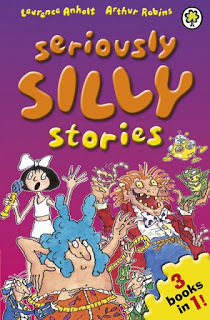
Our books were translated into 30 or more languages and they won several big awards. Here I am with Arthur Robins receiving the Smarties Gold Award with Konnie Huq from Blue Peter and two authors called Julia Donaldson and J.K. Rowling… whatever happened to them!

I took part in book events in Indonesia, Singapore and all around the world. Once Cathy and I travelled to South Korea to launch a full-scale stage musical of my Van Gogh book.
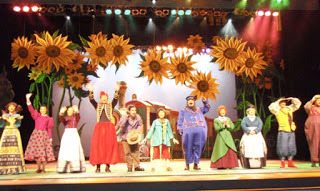 The Korean stage musical of Camille and the sunflowers. Copyright: Laurence Anholt
The Korean stage musical of Camille and the sunflowers. Copyright: Laurence AnholtIn those days, editors had the authority to accept a manuscript on the spot, but with the advent of Amazon and e-books, the threat to independent bookshops and the appalling cuts to public libraries, there has been an earthquake in children’s publishing. Now it feels as if publishing houses have erected forcefields around themselves armed by accountants! I know that many editors, authors and illustrators feel very sad about the commercialisation of this lovely industry and it must be horribly difficult to be starting out as an author or illustrator in 2015.
But back to that Golden time… I’ve always liked a little project and in 2005 I spotted a small shop for sale in Lyme Regis. Together with a group of friends, we constructed Chimp and Zee Bookshop by the Sea.
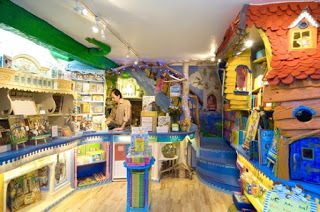 Chimp and Zee, Bookshop by the Sea. Copyright: Laurence Anholt
Chimp and Zee, Bookshop by the Sea. Copyright: Laurence AnholtIt was a little wonderland for children with a full-sized copper-leaved oak tree inside and a monkey (called Mumkey) who rode her bicycle endlessly around the window. This was the UK’s first author-owned bookshop and it was even shortlisted for an HSBC Small Business Award. Chimp and Zee was a magical place, but what we liked less were the nuts and bolts of retail and when the UK fell into recession, we sold the shop and set Mumkey free!
I am embarrassingly proud of the kind, funny and courageous adults that our kids have become. Claire graduated from Cambridge and works at a senior level in the UN Secretariat in New York. She does amazing work with climate change, Human Rights, and campaigning against child soldiers. Her lovely French husband, Adrien works in Disaster Relief.
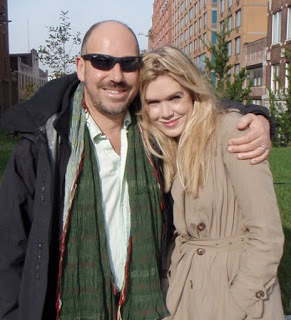 Claire and me
Claire and me Maddy is an actor, writer and radio presenter who has taken her one-woman show, ‘Maddy’s Many Mouths’ to the Edinburgh Fringe.
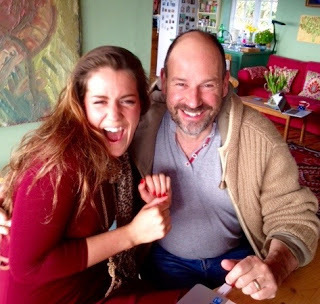 Maddy and me. There's a link to Maddy's website below.
Maddy and me. There's a link to Maddy's website below. Tom is an artist working in Berlin and his gorgeous paintings sell as fast as he can produce them, in galleries in Germany, Denmark, Italy and America.
 My son Tom. There's a link to Tom's website below.
My son Tom. There's a link to Tom's website below. The downside of being a home-parent is how much you miss them when they are gone. The solution is usually a little project, and in recent years Cathy and I have restored another neglected gem of a house. This haven of peace and creativity has light-filled studios overlooking the shimmering Axe Estuary near Colyton in Devon. We have wildflower meadows and beehives and we feel incredibly blessed to live in this magical place.

 At the bottom of the blog there's a link to an article about our renovation of Sunflower House.
At the bottom of the blog there's a link to an article about our renovation of Sunflower House. My mother, Joan Pickford, was a wise and wonderful woman who died too young. Joan was a teacher of English Literature, especially Hardy and Wordsworth and although she was a Christian, she was fascinated by Eastern philosophy. It must have influenced me because I became a member of the friendly Buddhist community in this area. If I had more pages I would gleefully expound on the benefits of mindfulness and meditation (such a wonderful tool for writing), but one central concept of Buddhism is that our thoughts become our reality - a person who thinks negative or prejudiced thoughts creates a dark claustrophobic world for themselves; conversely those who train themselves to be positive and open-hearted find the world opening around them. Life is challenging, but life is beautiful too. We are profoundly privileged to walk briefly on this extraordinary blue-green planet, revolving slowly in space.

A couple of years ago, something wonderful happened - I’ve always been an avid reader of fiction and I cherish that hour before sleep when one can explore another country or another mind from the comfort of one’s bed. I’ve always longed to write full-length fiction and I decided to take a year out to write two novels: ‘The Hypnotist’ and ‘Love Letters’. If picture books are hard, a novel is like building a house single-handed! But to my amazement, both books were accepted by the newly merged Penguin Random House. It’s been an incredible privilege to work with the legendary publisher, Annie Eaton and editor, Ruth Knowles - their enthusiasm for my work has been heartwarming. So here I am at 55 launching on a new adventure as a novelist. The Hypnotist is about prejudice and tolerance - In essence I have transposed Dickens’ Great Expectations to the Deep South of America in 1963. My protagonist is a young black orphan making his way against the background of Segregation and the dreaded Ku Klux Klan; (sadly, more topical than ever.) Because I’ve got a funny old brain, the book is a little stranger than a straightforward historical drama - all the events are seen through the very strange eyes of an outsider: an Irish hypnotist, Dr Jack Morrow, who has started work at a new university. There’s a slice of history, a sprinkle of magic realism and a twist of humour. The Hypnotist created a bit of a buzz at Bologna, although US publishers seem nervous of the subject matter! I’m so excited about this project and I’m already thinking about a third novel… I do like a little project, you know! The Hypnotist will be published by Penguin Random House in March 2016.
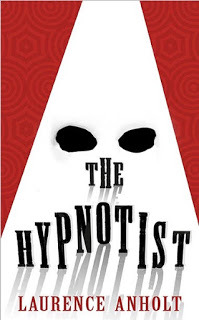 The cover of The Hypnotist
The cover of The HypnotistIf you’d like to chat about bees, books or Buddhism say hello on the Twit @LaurenceAnholt
Visit the Anholt website: http://www.anholt.co.ukPaintings by Catherine Anholt: http://www.catherineanholt.comSee our old shop here: https://www.youtube.com/watch?v=1eEnI... site: http://www.maddyanholt.com Tom's site: http://www.tomanholt.com Find out more about our renovation of Sunflower House: http://www.anholt.co.uk/renovation-of-sunflower-house-by-laurence-and-catherine-anholt/
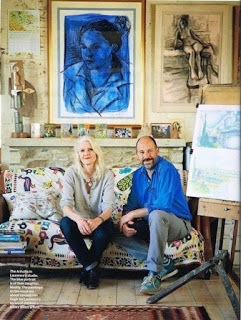 Catherine and Laurence Anholt in studio. Copyright: Alun Callender/Psychologies Magazine
Catherine and Laurence Anholt in studio. Copyright: Alun Callender/Psychologies Magazine
Published on July 23, 2015 19:30
July 18, 2015
Three Clever Ways to Build Up Your Climax by Natascha Biebow
Picture books are a tall order:
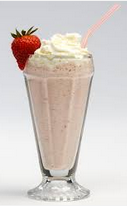
• a limited word count
• a unique premise
• an opening that needs to hook right away
• plus a satisfying ending, preferably with an unexpected twist.
But what about the middle?
You’ve got your character, your problem, a spiffy opening. The story rings with promise like an unwrapped present.

Then, the action starts. Your story reveals itself, bit by bit, like the giftwrap as it's peeled away. Your reader is filled with expectation: what could be inside?!
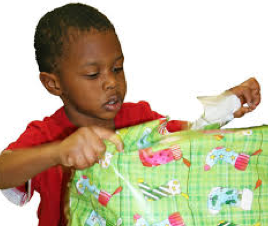
This bit needs to be page-turningly exciting, like a game of pass the parcel, where each layer reveals a little bit more and readers can't wait to find out what the big prize is. Don’t let your middle sag!
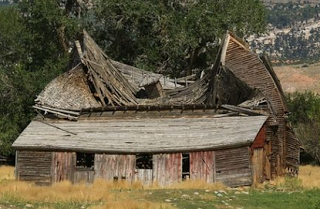 A sagging middle will make readers turn right off.But how? How can you make the middle really, really compelling?
A sagging middle will make readers turn right off.But how? How can you make the middle really, really compelling? 1. Use the rule of three: build up the plot and make things worse for the protagonist using three incidences that lead to a dramatic crisis and turning point in the story. This should be 75% of the way through your picture book, roundabout spread 7.
Make your characters face their worst fears,
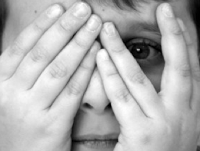
make time run out,
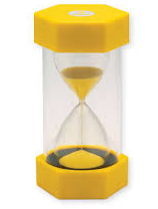
make your characters fall in the mud, get lost, or . . .?
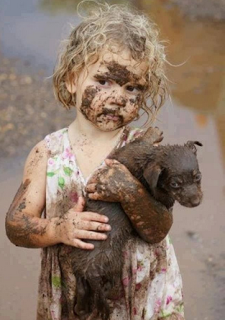
2. Create a pause (with words and visuals):


3. Use clever page turns and don’t be afraid to use the book format creatively:
TURN IT!


POP-UP, FLAPS or FOLD-OUT PAGES

USE BOLD WORDS

After the pause, you are ready for the big reveal:
 We get to see what was inside the present and everything changes. Ahh, an experience so satisfying, we can’t wait to do it again (and again and again!).
We get to see what was inside the present and everything changes. Ahh, an experience so satisfying, we can’t wait to do it again (and again and again!).Natascha BiebowAuthor, Editor and Mentor
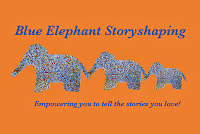 Blue Elephant Storyshaping is an editing, coaching and mentoring service aimed at empowering writers and illustrators to fine-tune their work pre-submission. Check out my Cook Up a Picture Book Small-Group Coaching Courses!
Blue Elephant Storyshaping is an editing, coaching and mentoring service aimed at empowering writers and illustrators to fine-tune their work pre-submission. Check out my Cook Up a Picture Book Small-Group Coaching Courses!Natascha is also the author of Elephants Never Forget and Is This My Nose?, editor of numerous award-winning children’s books, and Regional Advisor (Chair) of SCBWI British Isles. www.blueelephantstoryshaping.com
Published on July 18, 2015 20:00
July 14, 2015
The Big Wide World - Jonathan Allen - two days late. . . . sorry. . .

It's about this time of year that from every college and 'university' in the land, or at least a fair few of said institutions, fully fledged baby illustrators emerge, blinking, into the cold, hard daylight.
Well, I was once one of those.
In my hand, speaking figuratively, I had a list of children's publishers culled from my researches in the childrens section of Foyles in Charing Cross Road, London, which was next door to the Graphics Dept of St Martin's College of Art, where I was just completing my studies.
There were a few things I had to get my head round, amongst which was the idea that each publisher had its own 'list' with it's own special aesthetic, something that was not immediately obvious to a raw newcomer, and then to choose publishers with who's list and aesthetic my work would fit in. Not far short of guesswork basically.
So I did that to the best of my abilities and, showing commendable initiative, well, compared to some of my contemporaries anyway, rang the relevant art editors. I got a few appointments too, one being at J.M Dent who were located in a posh part of town, just next to Wimpole Street and Harley Street. Publishers seemed to be all located in interesting old buildings in places like Bloomsbury and Covent Garden for some reason.
I met the Art editor's assistant, as the art editor was away, and to her credit she told me to ring back when the art editor was back in a week's time, as my work was 'just up her street'.
Amongst the stuff in my portfolio were a few nonsense poems I had written and illustrated, and a very graphic but humorous version of 'There was an Old Lady Who Swallowed a Fly'. When I finally showed the art editor, (the late Vanessa Hamilton) my work she amazed me by suggesting that if I wrote some more poems, she might very well publish them as a book.
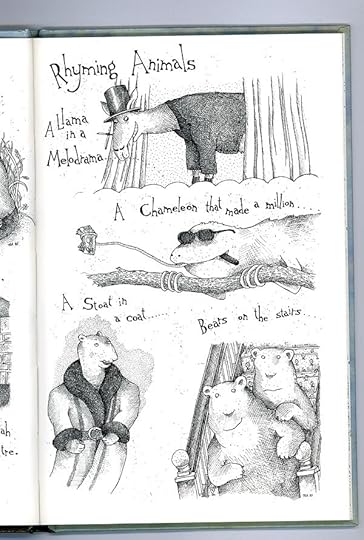

I went away and wrote some more poems and in due course a book was published. "A Bad Case of Animal Nonsense" came out in about 1978 (aaaaaargh! I can't possibly be that old can I?)
Not to a mad fanfare or to huge success, but it was a foot in the door and I managed to keep going from then on, helped by being in a great cheap housing co-op flat and having got used to living on student income levels, but it built up over time and I even manage to make a half decent living at it.
These days I don't know what the score is. To me it all looks pretty depressing, but my perspective is warped by my experience of the way things were back then, it bears little relation to the publishing world as it is now, especially from a new graduate's perspective.
The fortunate ones will find and take the opportunities that are out there, and the rest will find ways to get by, or find other ways of making a living. Just like in my day. Except in my day we didn't have student loans and tuition fees hanging over us. It makes me sad that economic conditions will very likely push the study of Art into being something feasible only for the rich. I wouldn't have been able to go to Art College without a student grant. . .
So, to all you illustrators, just out of college, trying to find a foothold in the world of work, I wish you all the luck in the universe. May you find some joy and satisfaction in what you find out there, whatever it may be. I look forward to seeing what you come up with.
Published on July 14, 2015 14:12
July 8, 2015
The World’s Most Awful Picture Book Writer by Kathryn Evans (Guest Blogger)
I have a secret ambition. I would LOVE to get a picture book published. My very first submission was a picture book - 15 years ago. It was rubbish. No really. It was terrible. To prove it, the script is reproduced in full below. I can’t actually believe I am showing you this, the levels of cringe rippling through me are probably registering on the Richter scale somewhere. Deep breath…oh god, even the ‘quirky’ font is making me feel faintly sick and the pictures? Forgive me illustrators for ever even thinking it…
The truth about witches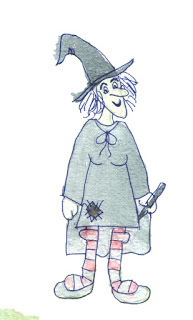 (Intro page) I know what you think about witches. For some strange reason all children do. But you are actually, quite wrong. I shall tell you the truth and then you can tell all your friends. And if they don’t believe you, show them this book. I am a very learned and wise person and know about stuff. Which is why I’m allowed to put it in books. Like this one.
(Intro page) I know what you think about witches. For some strange reason all children do. But you are actually, quite wrong. I shall tell you the truth and then you can tell all your friends. And if they don’t believe you, show them this book. I am a very learned and wise person and know about stuff. Which is why I’m allowed to put it in books. Like this one.
Here is a witch.She is very old and a bit stiff.It has taken her a long time at witch school to learn all her spells.
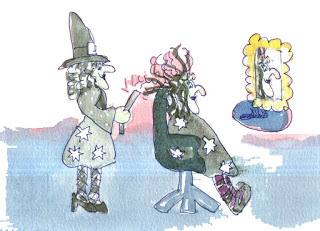 She earns her living by making people who think they are ugly think that they are beautiful.
She earns her living by making people who think they are ugly think that they are beautiful.
And greedy people rich (picture of stockbroker witch)And sad people happy (therapy witch)And sick people well (doctor witch)She has many talents and is often, offered money to turn mean people into frogs, I am sorry to say she can't really do this,She can only make people think that they are frogsAnd she only does that to very mean people indeed.This witch has a little house in a wood,You and I might call it a hovel,It is a bit untidyWith cobwebs dangling from the ceiling And washing up in the sinkAnd mouldy rubbish falling out of the binThere'sA big black cat called skittle And big black dog called Guinness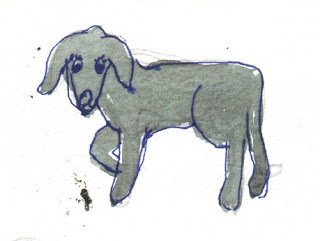 Five black rats called pot, lot, dot, spot and snotA whole tank of tadpoles (she has a pond in the garden of course)And a spider called Morris (which is why she leaves the cobwebs up)She has a very cosy armchair,A fridge full of her favourite food (tommyfartoes and gruesomebur salad, snaked beans, leeches and
Five black rats called pot, lot, dot, spot and snotA whole tank of tadpoles (she has a pond in the garden of course)And a spider called Morris (which is why she leaves the cobwebs up)She has a very cosy armchair,A fridge full of her favourite food (tommyfartoes and gruesomebur salad, snaked beans, leeches and scream and – most delicious of all – charmite sandwiches)A telly with her favourite programmes on (The Witch O Clock News and The Antique Wand Show)And a soft warm bed, with a fluffy quilt and two hot water bottles (one for each stiff old knee).SoCanYouTell meWhat on earth she'd be doing, trying to squish her poor old body into your bedroom cupboard, or behind your door where last week's stinky socks are, or even under your bed in all that dust and mess?Of course you can’t, because, quite clearly she would not. So you can happily go to sleep in your bed and she can go to sleep in hers. Except I haven’t yet written the book about why witches shouldn’t be afraid of children, then again, perhaps they should...
(Illustrations show children fishing in witch's pond, raiding her fridge, waving wands at the cat, etc...)
I do now want to die of shame. But you see what I mean? Pretty poor. Fifteen years on and I can see what’s wrong with it. Apart from the terrible pictures:1. There is no story. 2. There is no characterisation.3. There is no consideration to the page turns/construction of a picture book.4. There is no story.5. Quirky fonts do not make up for lack of story.6. There is no story.7. It’s basically a list of stuff about a witch.8. There is no story.9. And on and on and on…
But this script was the start of something for me – I sent it to Natascha Biebow who was then an editor at Random House (oh god, I actually sent this out, I really did, though thankfully even I recognised the pictures were truly awful and kept those to myself). To her endless credit, Natascha didn’t laugh in my face. She suggested I join SCBWI and learn how to write a story. I did exactly that. Over fifteen years I must have put in over 10,000 hours of practice (the bare minimum); I attended workshops and classes and I read and I wrote and finally, finally, I got a deal. But it wasn’t for a picture book. It was for a 70,000 word YA novel. Don’t get me wrong, I am thrilled about this. I love my publisher and I love my book and I am so so excited about getting it into the hands of children BUT I still want to write that break-through picture book and I am STILL finding it really hard.
I have structure, I have story, I have character but what I don’t have, what I’m still struggling with, is making every single one of the very few words you need for a picture book, count. I worked it out, if my text is 700 words, each one of those words is carrying the weight of 100 words compared to my novel. That’s a lot of weight. Writing picture books is hard. Really, really hard.
I have a plan though. I’m going back to Natascha. Now a freelance editor Natascha has set up Blue Elephant Story Shaping and she’s offered to work with me on my current attempt at a picture book. I’m going to crack it, I am! Just give me another fifteen years…
Kathryn Evans is the author of More of Me, due to be published by Usborne in February 2016. She blogs about writing at www.kathrynevans.ink . Her agent is sophie@sophiehicksagency.com
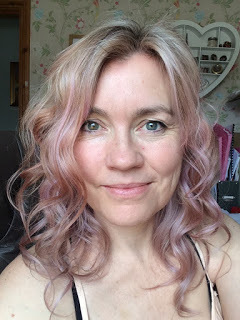
The truth about witches
 (Intro page) I know what you think about witches. For some strange reason all children do. But you are actually, quite wrong. I shall tell you the truth and then you can tell all your friends. And if they don’t believe you, show them this book. I am a very learned and wise person and know about stuff. Which is why I’m allowed to put it in books. Like this one.
(Intro page) I know what you think about witches. For some strange reason all children do. But you are actually, quite wrong. I shall tell you the truth and then you can tell all your friends. And if they don’t believe you, show them this book. I am a very learned and wise person and know about stuff. Which is why I’m allowed to put it in books. Like this one.Here is a witch.She is very old and a bit stiff.It has taken her a long time at witch school to learn all her spells.
 She earns her living by making people who think they are ugly think that they are beautiful.
She earns her living by making people who think they are ugly think that they are beautiful.And greedy people rich (picture of stockbroker witch)And sad people happy (therapy witch)And sick people well (doctor witch)She has many talents and is often, offered money to turn mean people into frogs, I am sorry to say she can't really do this,She can only make people think that they are frogsAnd she only does that to very mean people indeed.This witch has a little house in a wood,You and I might call it a hovel,It is a bit untidyWith cobwebs dangling from the ceiling And washing up in the sinkAnd mouldy rubbish falling out of the binThere'sA big black cat called skittle And big black dog called Guinness
 Five black rats called pot, lot, dot, spot and snotA whole tank of tadpoles (she has a pond in the garden of course)And a spider called Morris (which is why she leaves the cobwebs up)She has a very cosy armchair,A fridge full of her favourite food (tommyfartoes and gruesomebur salad, snaked beans, leeches and
Five black rats called pot, lot, dot, spot and snotA whole tank of tadpoles (she has a pond in the garden of course)And a spider called Morris (which is why she leaves the cobwebs up)She has a very cosy armchair,A fridge full of her favourite food (tommyfartoes and gruesomebur salad, snaked beans, leeches and (Illustrations show children fishing in witch's pond, raiding her fridge, waving wands at the cat, etc...)
I do now want to die of shame. But you see what I mean? Pretty poor. Fifteen years on and I can see what’s wrong with it. Apart from the terrible pictures:1. There is no story. 2. There is no characterisation.3. There is no consideration to the page turns/construction of a picture book.4. There is no story.5. Quirky fonts do not make up for lack of story.6. There is no story.7. It’s basically a list of stuff about a witch.8. There is no story.9. And on and on and on…
But this script was the start of something for me – I sent it to Natascha Biebow who was then an editor at Random House (oh god, I actually sent this out, I really did, though thankfully even I recognised the pictures were truly awful and kept those to myself). To her endless credit, Natascha didn’t laugh in my face. She suggested I join SCBWI and learn how to write a story. I did exactly that. Over fifteen years I must have put in over 10,000 hours of practice (the bare minimum); I attended workshops and classes and I read and I wrote and finally, finally, I got a deal. But it wasn’t for a picture book. It was for a 70,000 word YA novel. Don’t get me wrong, I am thrilled about this. I love my publisher and I love my book and I am so so excited about getting it into the hands of children BUT I still want to write that break-through picture book and I am STILL finding it really hard.
I have structure, I have story, I have character but what I don’t have, what I’m still struggling with, is making every single one of the very few words you need for a picture book, count. I worked it out, if my text is 700 words, each one of those words is carrying the weight of 100 words compared to my novel. That’s a lot of weight. Writing picture books is hard. Really, really hard.
I have a plan though. I’m going back to Natascha. Now a freelance editor Natascha has set up Blue Elephant Story Shaping and she’s offered to work with me on my current attempt at a picture book. I’m going to crack it, I am! Just give me another fifteen years…
Kathryn Evans is the author of More of Me, due to be published by Usborne in February 2016. She blogs about writing at www.kathrynevans.ink . Her agent is sophie@sophiehicksagency.com

Published on July 08, 2015 23:00



